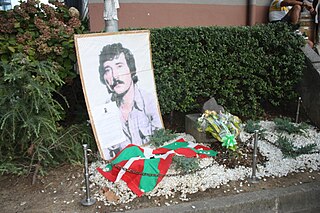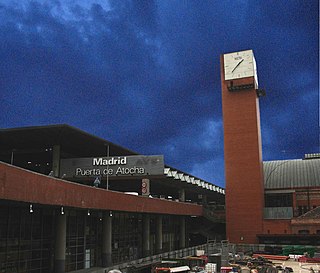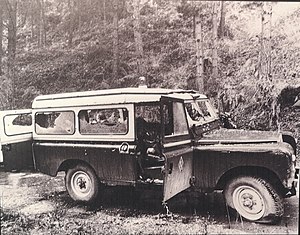
GAL were death squads illegally established by officials of the Spanish government to fight against ETA, the principal Basque separatist militant group. They were active from 1983 to 1987 under Spanish Socialist Workers' Party (PSOE)-led governments.

On December 30, 2006, a van bomb exploded in the Terminal 4 parking area at the Madrid–Barajas Airport in Spain, killing two and injuring 52. On January 9, 2007, the Basque nationalist and separatist organisation ETA claimed responsibility for the attack. The attack, one of the most powerful carried out by ETA, damaged the airport terminal and destroyed the entire parking structure. The bombing ended a nine-month ceasefire declared by the armed organisation and prompted the government to halt plans for negotiations with the organisation. Despite the attack, ETA claimed that the ceasefire was still in place and regretted the death of civilians. The organisation eventually announced the end of the ceasefire in June 2007.

The controversy regarding the handling and representation of the Madrid train bombings by the government arose with Spain's two main political parties, Spanish Socialist Workers' Party (PSOE) and Partido Popular (PP), accusing each other of concealing or distorting evidence for electoral reasons.
Jurdan Martitegi Lizaso is a member of the armed Basque nationalist and terrorist group Euskadi Ta Askatasuna (ETA). He is best known as the head of the military/commando unit of the group since late 2008 until April 18, 2009, when he was arrested by French police. He is considered to be one of the most dangerous members of ETA, considered a terrorist organization by the European Union, with police describing him as "extremely violent".
The 2009 Palma Nova bombing occurred on July 30, 2009, when a limpet bomb went off outside a Civil Guard barracks in the town of Palma Nova, Majorca, Spain. The bomb was placed under a patrol car and two Civil Guard officers died as a result of the explosion. A second device was found under another Civil Guard vehicle at nearby barracks and safely exploded by police. On August 9, the Basque nationalist and separatist organisation ETA claimed responsibility for the attack, while four other bombs exploded around restaurants and shopping centres in Palma, Majorca, causing no injuries.
The Vic bombing was an attack carried out by the Basque separatist group ETA which occurred on 29 May 1991 when a car bomb carrying more than 200 kg of explosive was detonated inside the courtyard of a Civil Guard barracks in the Catalan city of Vic, Spain. The bombing killed 10 people, including five children, and injured 44 people.

The 2008 Getxo bombing occurred on 19 May 2008, when a van bomb went off outside a boat club in the town of Getxo, Biscay in the Basque Country, Spain. The attack caused serious damage to the club, as well as nearby buildings and structures. No one was killed or injured after a warning call from the Basque separatist organisation ETA. On 31 May, the organisation claimed responsibility for the bombing.
The assassination of Juan María de Araluce Villar was a mass shooting attack by the Basque separatist group ETA which took place on 4 October 1976 in San Sebastián in the Basque Country in northern Spain. Three ETA members carrying pistols and submachine guns killed Araluce, the Government appointed President of the Provincial Deputation of Gipuzkoa and member of the Council of the Realm. Araluce's driver was killed in the attack together with three police guards. Ten bystanders were also injured in the attack, which was ETA's deadliest of 1976.
The July 1979 Madrid bombings were a series of bomb attacks carried out by ETA political-military (ETA-pm), a faction of the armed Basque separatist group ETA. The attacks, consisting of coordinated bombings in Barajas Airport and the train stations of Atocha and Chamartín, killed 7 people and injured a further 100. The bombings occurred a day after two attacks in Bilbao and San Sebastian, with both attacks killing two people.
The September 1982 Rentería attack was an ambush by the Basque separatist organisation ETA which occurred on 14 September 1982 on the motorway near the Basque town of Errenteria in Guipuzkoa. The targets were several national police officers, four of whom were killed in the attack, with the fifth seriously injured. The attack was ETA's deadliest of 1982.
The 1980 Markina attack was a mass shooting gun attack by the Basque separatist organisation ETA which occurred on 20 September 1980 near the Basque town of Markina. The targets were a group of off-duty civil guards who were having lunch in a bar in the town. Four civil guards were killed. The attack was one of the deadliest of 1980, the year when ETA killed more people than any other.
The Mutxamel bombing was an attempted car bombing by the Basque separatist organisation ETA which occurred on 16 September 1991 in the town of Mutxamel near Alicante. The target was the Civil Guard barracks in the town. However the bomb initially failed to explode near its target. The police treated the car as an abandoned vehicle, not realising that it contained a bomb and while being towed away, the car bomb exploded, killing two police officers and the civilian towing the car away. The bombing was the deadliest of the 40 attacks which ETA carried out in the Province of Alicante between 1979 and 2004.
The Vallecas bombing was a car bomb attack carried out by the armed Basque separatist group ETA in the Puente de Vallecas district of Madrid, Spain on 11 December 1995, which killed 6 people and injured a further 19. The target was a camouflaged army vehicle which was transporting nine civilian employees of the army towards the nearby motorway.

The Sabadell bombing was a car bombing carried out by the armed Basque separatist group ETA in Sabadell, Catalonia, Spain on 8 December 1990.
The October 1978 Getxo attack was a mass shooting gun attack by the Basque separatist organisation ETA which occurred on 22 October in the Basque town of Getxo, a suburb of Bilbao. The attack occurred six weeks before a referendum to approve a new Spanish constitution.
The 1980 Orio ambush was a gun and grenade attack by the Basque separatist organisation ETA which occurred on 13 July 1980 near the Basque town of Orio. The targets were a convoy of civil guards who had just finished their shift guarding the nearby munitions factory. Two civil guards were killed and three injured, while two ETA members were killed after the civil guards starting the new shift came to the assistance of their colleagues.
The assassination of Augusto Unceta Barrenechea was an attack by the Basque separatist group ETA which took place on 8 October 1977 in Guernica in the Basque Country in northern Spain.
The Grupos Armados Españoles (GAE) was a Spanish neo-fascist paramilitary organisation active from 1979 to 1980, primarily in the Basque Country. A report by the Office for Victims of Terrorism of the Basque Government in June 2010 attributed six murders to the group, and linked it to the National Police Corps, SECED and the Civil Guard.
The Alianza Apostólica Anticomunista was a Spanish far-right paramilitary organisation active from 1976 to 1983, primarily in the southern Basque Country but also in the French Basque Country and Barcelona. A June 2010 report by the Office for Victims of Terrorism of the Basque Government attributed eight murders with 66 deathly victims to the group and linked it to the National Police Corps, SECED and the Civil Guard. The group attacked the satirical magazine El Papus in Barcelona, killing one person and injuring 17.





